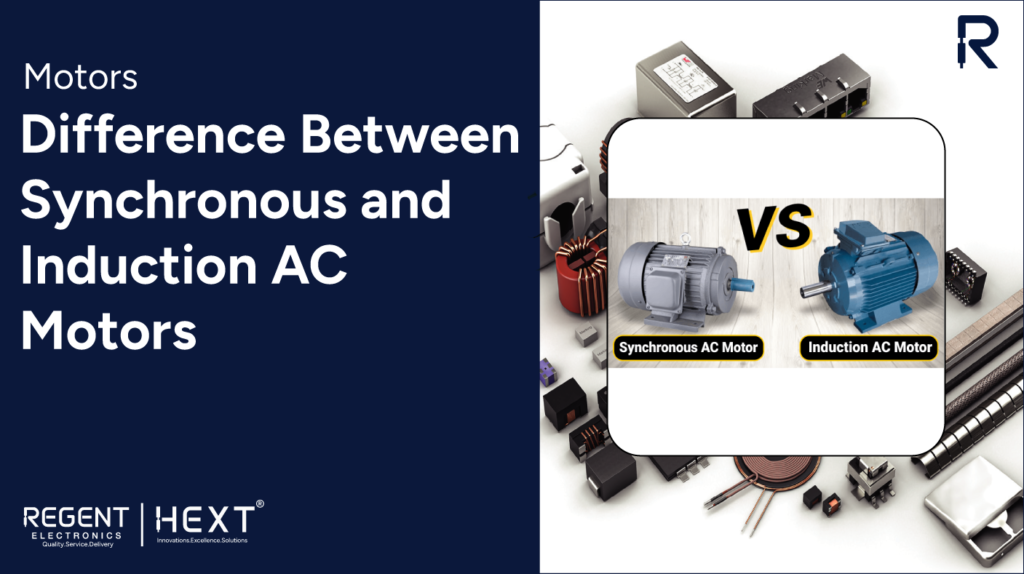
Difference Between Synchronous and Induction AC Motors
AC motors are widely used across both domestic and industrial applications. They convert alternating current (AC) into mechanical motion — but not all AC motors are the same. The two primary types are Synchronous Motors and Induction (Asynchronous) Motors.
In this guide by Regent Electronics, we’ll explore the key differences between Synchronous and Induction AC motors based on various parameters like excitation methods, speed, starting mechanism, efficiency, usage, and more.
🔧 What Is an AC Motor?
An AC motor converts alternating current electrical energy into mechanical energy using the principle of electromagnetic induction. Based on their construction and operational characteristics, AC motors are mainly categorized into:
- Synchronous AC Motors
- Induction (Asynchronous) AC Motors
Let’s break down each motor type and compare their functionalities.
⚙️ 1. Synchronous AC Motor

A Synchronous Motor is one that runs at a constant synchronous speed, regardless of the mechanical load. This speed is determined by the frequency of the AC power supply and the number of poles in the stator, calculated as:
Synchronous Speed (Ns) = 120f / P
(f = frequency in Hz, P = number of poles)
🛠️ Construction:

- Stator: Contains axial slots with windings designed for a specific number of poles.
- Rotor: Usually, a Salient Pole Rotor with DC field windings powered by slip rings. Alternatively, permanent magnets may be used.
⚡ Working:
When powered, the stator produces a rotating magnetic field. However, due to rotor inertia, the rotor does not start on its own. This is why a synchronous motor is not self-starting. It requires an external mechanism (like a pony motor or damper windings) to bring it up to synchronous speed.
⚙️ 2. Induction (Asynchronous) AC Motor

The Induction Motor—also known as the Asynchronous Motor—operates by inducing current in the rotor from the rotating magnetic field of the stator. It always runs at a speed slightly lower than synchronous speed, hence the term asynchronous.
🛠️ Construction:

- Stator: Wound for a specific number of poles.
- Rotor: Can be a squirrel cage rotor or a wound rotor. In squirrel cage motors, rotor bars are permanently short-circuited using end rings.
⚡ Working:
When the stator is energized by AC supply, it creates a rotating magnetic field that induces current in the rotor conductors. This induced current interacts with the magnetic field and generates torque, causing the rotor to rotate.
Unlike synchronous motors, induction motors are self-starting and widely used due to their simplicity and cost-effectiveness.
🔍 Side-by-Side Comparison: Synchronous vs. Induction AC Motors

| Parameter | Synchronous AC Motor | Induction AC Motor |
| Power Supply | Stator: AC supply Rotor: DC supply via slip rings | Stator: AC supply only |
| Type of Excitation | Doubly excited (AC for stator, DC for rotor) | Singly excited (AC only) |
| Operating Speed | Constant and equal to synchronous speed | Always less than synchronous speed |
| Starting Mechanism | Not self-starting; requires auxiliary means | Self-starting |
| Power Factor Control | Can operate at leading or lagging power factor by adjusting excitation | Operates only at lagging power factor |
| Primary Usage | Power factor correction + driving mechanical loads | Driving mechanical loads |
| Efficiency | Higher efficiency for the same voltage and power rating | Slightly lower efficiency compared to synchronous motor |
| Construction | More complex due to rotor excitation and slip rings | Simpler, especially in squirrel cage type |
| Cost | More expensive due to complexity and materials | More economical and widely available |
💡 Applications of Synchronous and Induction Motors
✅ Synchronous Motor Applications:
- Power factor correction
- Precision timing devices (e.g., clocks)
- Robotics
- High-performance industrial systems
✅ Induction Motor Applications:
- Household appliances (fans, washing machines)
- Industrial machinery (pumps, conveyors, blowers)
- Air conditioning systems
- Elevators and cranes
📌 Conclusion
Both synchronous and induction motors are essential components in modern electrical systems. Choosing the right motor depends on your specific application needs:
- Need precise speed and power factor correction? Go with a synchronous motor.
- Looking for a reliable, self-starting, cost-effective motor? The induction motor is your best bet.
If you’re still unsure which motor suits your application, feel free to contact our experts at Regent Electronics. We’re here to help you make the right choice for your automation and electronics needs.
